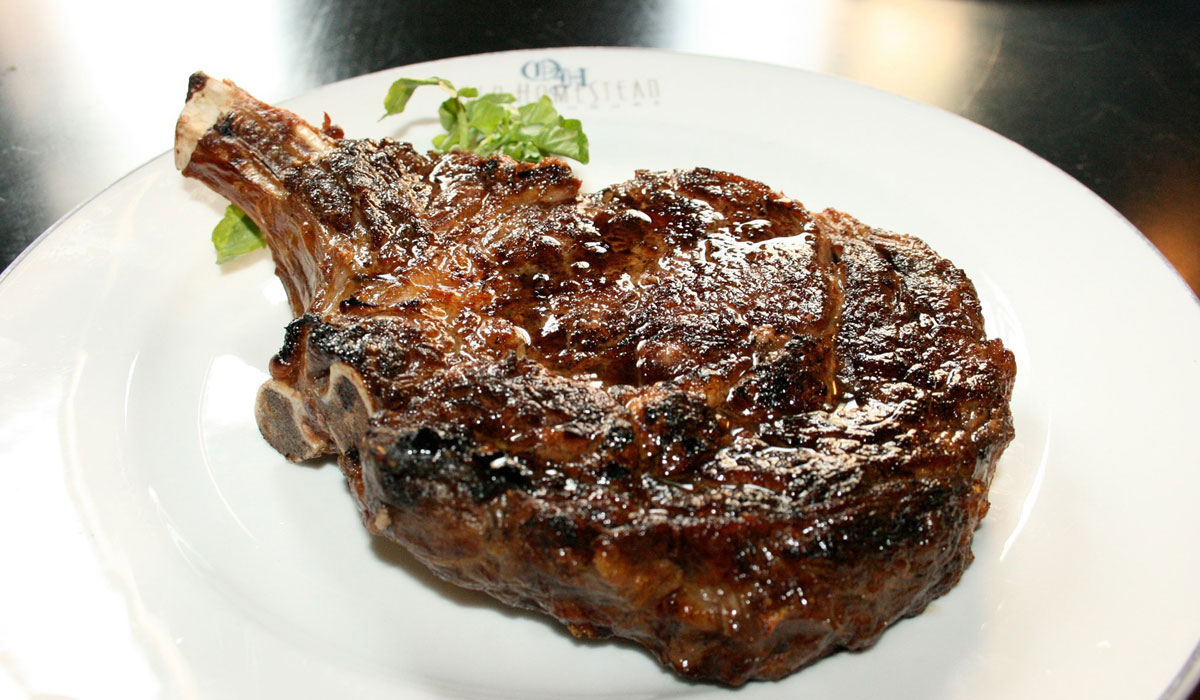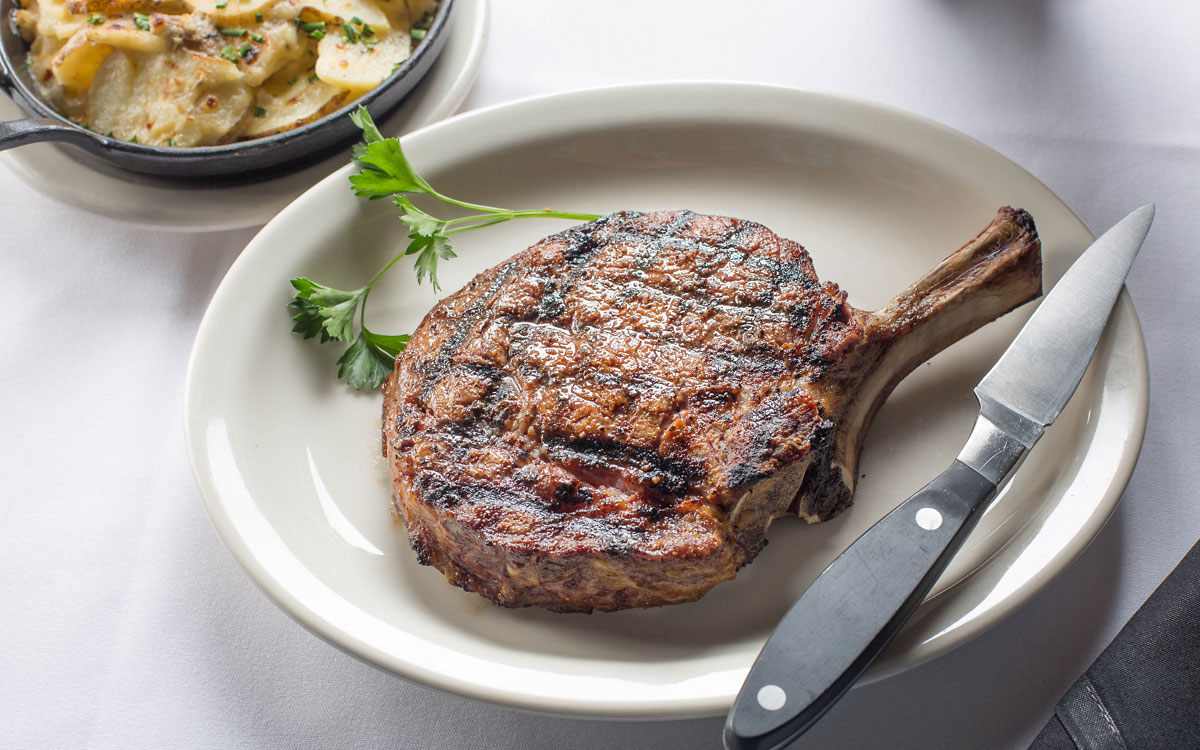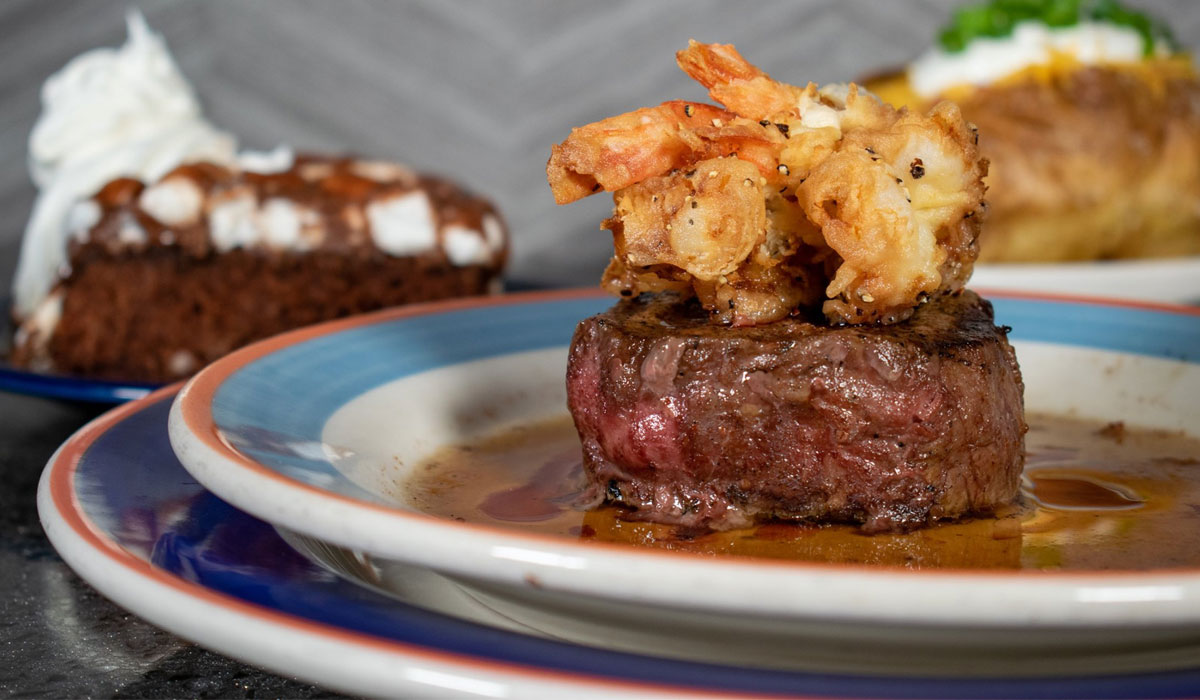













Long gone are the days of gluttonous celebrations where men stacked slices of bread to count the beefsteaks they had eaten. The culture around steakhouses and the full-service industry have changed significantly throughout the years, as these 13 iconic concepts can attest.
Even so, these operations continue to make nods or overt tributes to the times when they first opened their doors to the public, and that’s something that resonates with generational customers as well as new ones.
Here are the 13 of the most legendary steakhouses in the U.S. Note: all opened before 1950.
New York City
When a German family established the Old Homestead Steakhouse 151 years ago, it was known as Tidewater Trading Post. In the 1940s, Harry Sherry purchased the restaurant after working his way up from dishwasher.
Sherry passed the restaurant on to his grandsons, Greg and Marc Sherry. The two have worked to keep a focus on the traditions of the restaurant, which claims to be the oldest continuously operating steakhouse in the U.S.
“Why change something that has worked for 150 years?” Greg Sherry says on the restaurant’s website.
Even so, the restaurant says it became the first to introduce Kobe and Waygu beef from Japan, after the brothers worked with Japanese farmers to have their facilities comply with American health code standards.
Old Homestead’s high-quality menu allows it to create show-stopping packages, like their $53,000 “Beef and Bling” Superbowl LIII package, which included a reported 53-pound imported Japanese Wagyu roast and 12 $750 bottles of Cristal champagne, among other forms of snacks made from Old Homestead style.
New York City
Known for its mutton chops and tens of thousands of tobacco pipes, Keens Steakhouse was founded by theater producer Albert Keen. The restaurant was originally a spot for the Lambs Club theater group to congregate, sometimes grabbing a drink during the show’s intermission.
Keen’s tradition of keeping pipes for patrons began in the early 20th century. As many as 50,000 hard clay churchwarden pipes were ordered from every three years. When they were delivered, a pipe warden would register and store the pipes and pipe boys would retrieve pipes from storage and bring them to patrons. Over 90,000 pipes are contained in the Pipe Club’s roster.
The clientele evolved to include other professions and a focused was shifted to food from just smoking. Even so, pipes from notable guests are displayed with pride, include those from President Teddy Roosevelt, Babe Ruth, JP Morgan, and General Douglas MacArthur.
New York
Originally opened in 1887 as “Carl Luger’s Cafe, Billiards and Bowling Alley,” this steakhouse quickly became a neighborhood favorite. Peter Luger owned the restaurant while his nephew, Carl, operated the kitchen. The Williamsburg Bridge opened in late 1903 and the restaurant was then frequented by businessmen crossing the East River.
Sol Froman, a 17-year-old who worked full-time lighting street lamps, established Forman Family in 1920 with his siblings. The company made various metal products and Forman would often take potential buyers and clients to the famed restaurant across the street.
The restaurant came into hard times upon the death of Peter Luger and went to auction. Forman, the sole bidder, worked to restore the restaurant to its former glory. The restaurant remains under the Forman family’s management and has earned a Michelin star.
Denver
Founded in Denver, this restaurant is one of the oldest steakhouses outside of New York City, with the first liquor license in the state of Colorado. The founder, Henry Zietz, met the famed Col. William “Buffalo Bill” Cody at the age of 10 and, within two years, was riding with Cody’s band of scouts. When Zietz died in 1949, the last of the famous band was gone.
Since its founding, the restaurant has served all types of clientele, including cattlemen, miners, railroad builders, silver barons, Native American chiefs, and businessmen. President Theodore Roosevelt dined at the restaurant in 1905 when his Presidential Express train arrived in Denver. He then asked Zietz to be his hunting guide as they traveled Colorado’s western slope.
The walls are decorated with numerous historical memorabilia and cultural artifacts, including a 575-piece taxidermy collection and 125-piece gun collection. A local group of investors purchased the restaurant in 1978 and were careful to not disturb the basic exterior of the structure, which was designated a historical landmark by the City and County of Denver in 1972.
Indianapolis
Joe Stahr chose St. Elmo, the patron saint of sailors, as the name for his steakhouse when he founded it in 1902. The restaurant was then turned over to Harry Roth and Isadore Rosen from 1947 to 1986. Stephen Huse took over and, in 1997, partnered with his son, Craig, who is the current operator.
St. Elmo’s has won various awards since opening in 1902, including being named a America’s Classic by the James Beard Foundation.
The restaurant has also been featured in a number of TV shows, including the Travel Channel’s Man vs. Food and NBC’s Parks and Recreation.
Oklahoma City
Not only is it one of the oldest steakhouses in the country, but Cattlemen’s Steakhouse is the oldest restaurant in the state of Oklahoma. The area was a hotbed of activity with ranchers and cattle haulers, which Cattlemen’s was able to satisfy early in its years of operation.
During the first couple of decades of Cattlemen’s existence, the steakhouse was one of only a few places that stay open after sundown, leading to what the steakhouse calls “very colorful clientele” coming in to eat.
The steakhouse has changed hands a number of times since opening over a century ago. The shift most integral to the growth of the establishment came in 1945. Hank Frey, who owned the steakhouse at the time, was facing hard luck during a dice game at the Biltmore Hotel. He wagered the restaurant and Gene Wild, a local rancher, wagered his life savings.
Wild rolled what he needed to win, and the 33 brand has been placed throughout the restaurant as a show of Wild’s fortune.
Numerous notable individuals have dined at the steakhouse. Ronald Reagan, before he was president, and George H. W. Bush, while he was president, both stopped by. A number of music stars and celebrities have also sat down for a steak and a drink.
Los Angeles
Fred Cook originally dreamed of performing in grand operas, even understudying the famed Enrico Caruso. When his vocal skills didn’t lend itself to success, Cook and his wife, Grace, or “Lovey” as friends, family, and eventually their Los Angeles customers called her, packed up and headed west.
The pair had an idea for a restaurant outfitted like a dining car after they ate in a similar establishment before they left New York. They began building the restaurant in a friend’s backyard. They increased the size of the restaurant to add tables and chairs and a long bar inside. They also added wheels and moved the restaurant in the dead of night to avoid traffic.
The restaurant was not immune to the hard times of the 1930s, and Virginia Cook, the founders’ daughter, came back to southern California to find better opportunities and worked in the restaurant to help out. She said in the restaurant’s website that she remembers the staff helping out those in need.
“We’d have at least three or four people a day asking for any kind of work, or just a meal. Lovey would always tell them, ‘Come back at 9. That’s when the staff eats, and you’re welcome to a free meal with us,’” she said. “Many of them did, and then Fred and Lovey would take whatever was left over in the kitchen down to the mission.”
The restaurant has been featured HBO’s Shameless and the film Training Day, where Denzel Washington’s character recommends the baseball steak.
New York City
Amid the era of prohibition in the U.S., former Ziegfeld girl Helen Gallagher—wife of vaudeville comedy personality Ed Gallagher—and her partner, Jack Solomen, opened Gallaghers Steakhouse.
After the original owners passed away, the steakhouse eventually ended up under the ownership of Jerome Brody in 1964. The steakhouse began opening for lunch, windows were installed in the meat locker, and the steakhouse took on a new brand and feel.
Dean Poll then purchased the restaurant in 2013 and reopened in 2014, with a stated commitment to returning the steakhouse to former glory.
“It is a part of the fabric of New York and I’m privileged to be a part of it,” Poll said on the restaurant’s website.
Patrons today can still come in and see the Canvas of Stars mural that Brody’s widow Marlene had commissioned in 2006, featuring historical icons such as Muhammad Ali, Joe Dimaggio, and JFK. They can also see the steakhouse’s 14 chandeliers that have been restored and hung once again, dating back to the 1940s.
Chicago
Gene Michelotti came to the U.S. from Italy at the age of 15. He spoke very little English but worked a number of jobs, including bartending, where he met his future business partner, Alfredo “Georgetti” Federighi, who was a chef at the time.
The pair founded Gene and Georgetti in 1941, making the restaurant the oldest steakhouse in Chicago. Upon Michelotti’s death in 1989, his daughter and son-in-law purchased the restaurant, wanting to keep it within the family.
Numerous celebrities have dined at the steakhouse, including legends like Frank Sinatra and Bob Hope and modern names like Russell Crowe and Will Ferrell. The restaurants boasts it also has seen local, national, and international politicians, and a legion of regular customers, some of more than 50 years of patronage.
Multiple locations
The southernmost restaurant on the list, Doe’s Eat Place was originally opened in 1903 as a grocery called “Papa’s Store.” Dominick “Big Doe” Signa ran the store until a 1927 flood and then went into bootlegging to support the family.
He then sold his 40-barrel still for $300 and a Model T Ford. Around 1941, Signa’s wife received a partial recipe for tamales and, after improving the recipe, the pair went into the restaurant business. Signa ran a honky tonk in the front of the store and had white customers come in the back to eat, which the restaurant website refers to as segregation in reverse.
One of the local doctors came in between calls and Signa would cook him a steak and feed him in the back. That doctor eventually brought doctors and lawyers and, in time, Signa had a functioning restaurant in the back of the store. He shut down the honky tonk and focused on the restaurant.
Doe’s Eat Place’s staff cherishes the toll time has taken on the building, the website says. It only adds to the atmosphere of dining at an old family restaurant with the 1940s feel of it.
The restaurant also has the most locations of the restaurants on the list, with two family owned locations in Mississippi and Kentucky and 13 franchise locations in Arkansas, Louisiana, Mississippi, Missouri, Oklahoma, and Alabama,
Omaha, Nebraska
An Omaha tradition for more than 70 years, Gorat’s Steak House was founded by Louis and Nettie Gorat, and subsequently by their son, Louis, Jr. Gene Dunn bought the restaurant in fall of 2012 and renovated.
The restaurant, a favorite of Berkshire Hathaway CEO Warren Buffett, is now without the drop ceilings, wallpaper, wood paneling, and carpeting. Dunn also expanded the menu and hours, rather than remaining closed from 2 p.m. to 5 p.m.
Portland, Oregon
This steakhouse touts a surprising menu choice as one of its best, and it’s not steak. RingSide Steakhouse’s onion rings were apparently claimed by James Beard as “the best I’ve ever had.” The steakhouse has received numerous awards, from high ratings from the Portland Business Journal to the DiRoNA Award of Excellence.
The name refers to the boxing decor the steakhouse throughout it’s uptown location. The steakhouse has also expanding to a Fox Tower location titled “RingSide Fish House.” There also briefly a “RingSide Grille” at the Glendoveer Golf Course from 2015 to 2017.
Minneapolis
Before Art and Marie Murray moved to Minneapolis from Wisconsin, the building they would eventually occupy was already filled with history. Built in the 1880s, it was originally home to the Hankow Cafe.
The couple first opened The Red Feather Cafe in downtown Minneapolis in 1933 and, after moving the first restaurant to the Russell Hotel in 1939, they debuted Murray’s in 1946. Not only did they quickly develop a reputation for fine dining, Art Murray also invented and sold restaurant-focused inventions to other owners to help common service issues.
Marie Murray’s cousin, Alois Schirle, traveled to Minneapolis to become to the restaurant’s master baker. He and Murray developed the recipes for the brand’s garlic bread, which is still used in the restaurant today along with the recipes for pretzels and pies.
The couple’s son, Pat, who started as a dishwasher, took the reins in 1960 after marrying his childhood sweetheart. Pat Murray and his wife, Joyce, had five children, three of which continue to serve on the restaurant’s management team.








